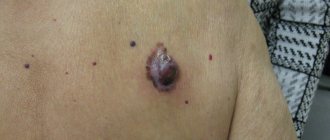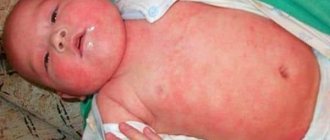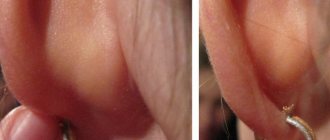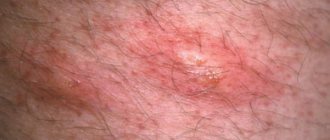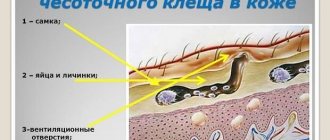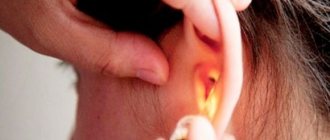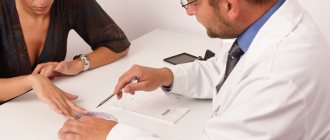The most common source of fungal infections worldwide are dermatophytes. These fungi settle on the skin, live, reproduce, and eat its keratinized areas. Eventually they completely destroy the topmost layer of skin.
What are dermatophytes, the causes of dermatophytosis, its types, diagnosis and treatment will be discussed below.
Treatment of the disease
Therapy for the disease can be different; it can only be prescribed by the attending physician.
- Local treatment.
- Systemic.
Therapy for the disease is aimed at getting rid of the disease and its symptoms. If the fungal infection affects only the skin and does not affect the hair and nails, treatment can only be applied externally and locally.
Dermatophytosis of the feet is treated with Lamisil, which helps against molds, dimorphic and dermatophyte fungi. It can have a detrimental effect on the fungus, and after its use there are practically no relapses. It is used not only to treat fungal infections, but also to prevent such diseases.
In order to save the patient from such a disease, the doctor prescribes synthetic medications that are used not only locally, but also internally.
In addition to Lamisil, clotrimazole, econazole, and ketoconazole are prescribed. They need to be used approximately four times a day for fourteen days.
In order to reduce sweating, you can wash the areas of the skin affected by the fungus with various decoctions, such as chamomile, burdock, and oak bark.
Dermatophytosis often appears due to a mixed infection that must be treated with complex therapy. For this purpose, Diflucan, Forkan, Sporonox are prescribed, and ten percent salicylic ointment is also used.
To reduce swelling of this area or an allergic reaction, it is necessary to apply a lotion with tannin or ethacridine. And if this area is severely inflamed, you need to use a combination remedy.
Medications in spray form are very good for treatment. For example, to quickly eliminate a symptom, you need to spray Lamisil spray on the affected area. It is applied in a thin layer, limiting the spread of infection to other areas. After some time, the areas of the skin treated with the spray become pale and dry. Itching, burning and painful sensations disappear.
Today, there are many medications aimed at combating fungal infections. Therefore, when choosing a drug, the doctor will be able to select an effective treatment, individually for each patient. Since medications can be for local use and for internal use, therapy can be carried out in a comprehensive manner.
Danger and possible complications
The danger depends on the neglect of the patient's condition. If you quickly identify an infection and immediately begin proper treatment from a specialist, then the risk of complications is not so great.
If the condition is severe, a secondary infection can easily occur. On the skin, a staphylococcal infection can often join the fungus. This causes severe inflammation of the skin with copious formation of pus. Such infections often leave scars on the skin for life.
Secondary infection is not the only complication . The process of eczematization of the skin is possible. Which causes a number of unpleasant symptoms: itching, the appearance of red, keratinized spots, the formation of blisters and pustules. This brings discomfort and spoils the aesthetic appearance of the patient, which for many is a serious blow to the psyche.
Treatment methods for the disease in men and women
The treatment regimen for dermatomycosis involves the use of pharmaceuticals, folk remedies, and physiotherapy, which plays a supporting role in the treatment of this disease (the growth of fungi is suppressed with the help of irradiation devices).
Medication
Pharmacists have developed more than a hundred drugs with antifungal effects. Only a specialist can correctly select them for a specific patient. Medicines include:
- External agents (ointments, creams, sprays, gels). They are applied twice a day, only to clean skin, otherwise they will not be able to penetrate deep into the skin and begin to work. The course lasts on average 10 days, the first positive results appear on the 4th day. Popular drugs include Miconazole, Ketoconazole, Mycoseptin, sulfuric and salicylic ointment.
- Antiseptics for treating wet areas - Chlorhexidine.
- Antihistamine medicine – Suprastin.
- Antimicrobial agents. Used internally in severe, advanced cases, and only as prescribed by a doctor - Griseofulvin.
- Vitamin preparations. Accelerate healing processes.
Folk remedies
The main task of these drugs, which are actively used at home, is to relieve skin inflammation and relieve the patient from painful itching. Unfortunately, folk remedies cannot cure completely, so a visit to the doctor is by no means ruled out.
Here are a few recipes proven by many years of practice:
- Baths with oil (sea buckthorn, olive). For 0.5 liters of water, oil will require 2 tbsp. Sore hands or feet are dipped in the liquid for 20 minutes.
- Lotions with a decoction of oak bark or chamomile.
- Lotions with boric acid (50 g per 1 liter of water). They can be applied to inflamed areas at night. Course – 10 procedures.
- Lotions with natural coffee. Ground grains are diluted with water to obtain the consistency of sour cream. A cotton pad with this remedy is applied to the area of inflammation for 30 minutes.
- A leaf of fresh cabbage, smeared with sour cream. Apply to lesions.
- Baths with celandine. 1-2 liters of decoction per bath.
- Ointment made from 1 egg yolk and 1 tsp. pharmaceutical tar. Infected areas are lubricated 2-3 times a day.
- Powder made from ground rice grains and talc in a 1:1 ratio.
- Iodine nets. The procedure is performed once a day.
- Decoctions of herbs (calendula, sage) to strengthen the immune system. Take 1 tbsp orally. in a day.
- Tar soap as a daily hygiene product.
- A 30% vinegar solution for preventive treatment of the inner surface of shoes.
Methods of therapy
There should be a systematic and comprehensive approach to the treatment of dermatophytosis. Therapy for this skin disease is long-term, involving a combination of various antimycotics and methods of their administration. It is often necessary to replace one drug with another due to low effectiveness or the occurrence of negative side reactions. Tactics are determined by the treating dermatologist.
Antifungal agents are used orally and topically. As a rule, disinfection of skin lesions is carried out in parallel. For any form of pathology, hyposensitizing therapy is indicated, since fungi cause allergization of the body.
Onychomycosis
Treatment of an infection that damages the nails is the most time-consuming, complex and expensive. A combination of systemic therapy and local treatment of lesions is required.
The following drugs are effective among antimycotics:
- Terbinafine is the gold standard in the treatment of skin lesions. Advantages: destroys fungi, has an intermittent dosing schedule to reduce the drug load, combines well with varnishes. Available in tablets for oral administration and solutions for external treatment.
- Griseofulvin - helps with microsporia, stops the proliferation of pathogens, is available in tablets and in the form of linement.
- Itraconazole is used by pulse therapy. Capsules are taken 7 days a month for six months.
- Fluconazole - a loading dose is administered once a week, used for a long time orally or as an infusion.
Hand nails are treated for up to 6 months, toenails - sometimes for a year. The drug dosage regimen is individual, the duration and frequency of therapeutic courses is determined by the doctor.
Antifungal varnishes, ointments, and aerosols have been developed (Lamisil, Mikozolon, Triderm, Travocort). Local use of antimycotics without systemic therapy is effective only when 1-2 nails are affected and in the initial stages of onychomycosis.
Dermatophytosis of various localizations
First of all, the above antifungal agents are used. But there are features of treatment tactics for various forms of pathology.
Dermatophytosis of the feet, occurring in an erased form and with the predominant localization of foci in the interdigital spaces, can be defeated by external treatment. Sometimes the same effect is achieved with the help of disinfectants. The course of treatment for fungal skin lesions usually lasts about a month. But to obtain a reliable result, systemic drugs are prescribed. Keratolytics are also used to remove excess stratum corneum and soften the skin.
Dermatophytosis of the hands requires treatment with antifungal drugs for several weeks. With this form of dermatophytosis, disinfection of the lesions is mandatory: antimycotics are used, sometimes in combination with hydrocorticosteroid hormones, aerosols and lotions with antiseptics (resorcinol, silver nitrate, potassium permanganate).
Treatment of dermatophytosis of smooth skin lasts about 1 month or until the lesions disappear. Aerosols and ointments are the same as for foot lesions. Hormonal ointments cannot be used, since the pathology takes a protracted course and subsequently becomes extremely resistant to therapy.
External disinfection is effective only in the early stages of skin lesions and in the absence of lesions on the face. To consolidate the result after the disappearance of pathological manifestations, treatment should continue for another 7-10 days. Therapeutic agents are applied to the lesion, covering 3 cm of healthy tissue outward from its border.
Treatment of inguinal dermatophytosis almost always involves the use of systemic antifungal therapy and is carried out according to the same schemes.
In addition to specific drugs, pathogenetic therapy is necessary for any variant of the disease:
- vasoactive agents (nicotinic acid, Troxevasin, Pentoxifylline);
- medications that improve trophic processes (Actovegin);
- vitamin therapy;
- immunomodulators;
- mineral and vitamin complexes.
When a secondary infection develops and a purulent process begins, antibiotics and local disinfection of the lesion are indicated.
Pathogens of dermatomycosis
Ringworm is caused by fungi, so the main cause of its occurrence is poor hygiene. Direct contact with a sick person can also cause dermatomycosis infection. Even touching things that have been touched by a person with dermatomycosis can become dangerous for a healthy person. Such items may include: comb, towel, kitchen items.
Very often, people become infected with dermatomycosis on public transport by simply touching handrails and handles. To avoid this, you need to regularly treat your hands with an antiseptic. Ringworm can also affect a healthy person through contact with animals. It is for this reason that you should not approach stray dogs and cats.
The causative agents of dermatomycosis are divided into three main groups of fungi:
- Microsporum.
- Epidermorhyton.
- Trichophyton.
These fungi have the ability to absorb keratin.
Favorable temperature for the development of dermatophytes is 26-30 degrees. It is for this reason that most people become infected with dermatomycosis in the summer. Air humidity creates even more favorable conditions for the development of this skin disease.
Therefore, it is extremely important to pay attention to the slightest symptoms of the development of dermatosis in order to avoid its transition to a chronic form.
A hereditary disease that occurs as a type of dermatosis is ichthyosis of the skin.
The body's immunity also plays an important role in the development of the disease. Hormonal imbalances and disturbances in the general metabolic balance can increase the risk of dermatomycosis. Vitamin deficiency can also contribute to the development of the disease.
Types of mycoses and characteristic symptoms
Mycoses of smooth skin, the symptoms of which depend on the pathogen, should be treated in a timely manner. Some types of disease are highly contagious. A common feature of all mycoses of smooth skin is the destruction of keratin, as a result of which the epidermis becomes thinner, peeling begins and itching may appear.
Types of mycoses:
- dermatomycosis;
- keratomycosis;
- candidiasis.
Dermatomycosis or dermatophytosis is a lesion of smooth skin and hairy areas of the body by dermatophytes. These fungi spread easily from person to person. When the pathology affects smooth skin, swelling and redness of the epidermis, excessive peeling and itching are observed.
Mycosis of smooth skin is difficult to distinguish from other dermatological diseases from photographs. For an accurate diagnosis and treatment, it is recommended to consult a dermatologist.
Keratomycosis is a group of diseases characterized by impaired skin pigmentation due to the destruction of keratin. The most common disease of this group is lichen versicolor, which also belongs to mycoses of smooth skin. This disease is accompanied by the appearance of spots of all shades of brown. The spots stand out against the background of a healthy epidermis only in color; there is no itching or swelling, but thinning and flaking of the skin in the affected area may be observed. Most often, the disease affects the skin of the back, chest or abdomen.
Smooth skin candidiasis is a disease caused by a yeast fungus of the genus Candida. Characteristic symptoms: red spots and stripes similar to diaper rash, swelling of the skin, severe itching, peeling of the skin around the spot.
Forecast
Dermatophytosis can be treated quickly enough with fungicidal agents if detected early
If symptoms are detected in a timely manner, dermatophytosis can be treated quite successfully and disappears without a trace. On average, therapy lasts about 4 weeks if smooth skin is affected, and about 8 weeks in case of damage to the hairy areas of the body and scalp.
Foot fungus goes away on average in 2 months. Treatment of fungus on the hands takes 3-6 weeks, depending on the severity of symptoms.
Onychomycosis takes a long time to treat; complete cure occurs only after healthy nails grow back. If the fingers are affected, it takes about 6 months; if the toenails are affected, the duration of treatment reaches 9-12 months.
Treatment
Successful treatment of dermatomycosis in humans directly depends on the accuracy of identifying the pathogen and the patient's compliance with the prescribed therapy. The general treatment regimen includes a therapeutic approach and medication: strengthening the immune system and destroying the fungus. Only an integrated approach and further prevention will guarantee that the disease will not recur.
There is no specific technique or treatment regimen. Drugs, courses, and methods of supporting medications are prescribed exclusively for a specific patient. Self-medication is strictly contraindicated if the patient does not know what specific fungus he has (self-therapy is permissible only for chronic forms).
Drugs
During treatment, antifungal drugs are supplemented with immunostimulants and vitamins. This is done so that the body more actively fights the fungus, and the healing of the lesions occurs faster. For superficial mycosis, special ointments or creams are sufficient to combat the pathogen; occasionally, oral medications (with high toxicity) are prescribed. Severe cases require the use of antibiotics and hormonal anti-inflammatory drugs.
Systemic drugs
The drug Itraconazole is a synthetic antimycotic drug with a broad spectrum of action. Effectively fights all types of pathogens. The minimum period of admission is 2-4 weeks. It is strictly forbidden to take the drug on your own due to its high toxicity. The list of contraindications and mandatory side effects is so long that it is advisable to use this remedy when other methods do not help. After the symptoms disappear, treatment is continued for another week.
The drug Fluconazole suppresses the activity of dermatomycosis pathogens and stops their growth. The drug is not prescribed to vehicle drivers, machine operators, and pilots because it causes regular dizziness and disorientation in space and time. The substance in the medicine, azole, requires a large amount in the body; tablets must be taken directly with meals.
Antifungal ointments
Pimafukort is an antifungal ointment containing antibiotics. Successfully fights against dermatomycoses on the skin. Reduced effectiveness is observed in the treatment of fungal diseases in the scalp. Do not use on open wounds on the skin or viral infections. Otherwise, it has no contraindications (except for individual intolerance). It can be used even in children under 1 year of age under medical supervision.
Advantan is an antifungal glucocorticoid cream, a highly effective drug. In fact, it is not absorbed into the blood. Acceptable for use for the treatment of foci of dermatomycosis on the face and external genitalia. It is not recommended for use by pregnant women and during lactation. Otherwise, the cream has no contraindications. Do not use for viral skin infections.
How to treat in an advanced stage
There are several methods of such therapy, which are briefly described below.
Hardware processing
Hardware processing is safe since no cutting tools are used. This treatment of nails and foot skin is especially recommended for people with diabetes, where any scratch can be fatal. Plus, only disinfectant solutions and disposable instruments are used, so the pathogen will not be transmitted to other clients or the technician himself. In combination with fungicidal drugs, hardware treatment of nails increases the effectiveness of treatment by 86%.
Ozone therapy
Ozone therapy is not the main method of treating dermatophytosis, but it significantly improves the course of the disease. Ozone is very unstable, so it can easily penetrate the cell wall of fungi, destroying them and preventing their spread. Therefore, it is often used to remove mold and disinfect swimming pools.
Ozone also improves the access of oxygen to tissues, and this promotes rapid regeneration of affected areas. But the method has a number of contraindications, so before going to a dermatology clinic or cosmetology center, you should consult with your doctor.
Laser method
The effectiveness of laser treatment has been proven when affecting fungal cultures in a nutrient medium. A high-intensity laser turned out to be most effective in suppressing the growth of fungal colonies. This treatment works well and improves the prognosis in the treatment of onychomycosis.
Typically, topical therapy cannot penetrate deep into and under the nail plate. But the laser can penetrate deep layers and inhibit the growth of fungi. An undoubted advantage is that this method has virtually no contraindications and does not cause any discomfort.
Classification of the disease
More than thirty different pathogenic fungi can cause infection on the skin
Dermatomycoses are classified according to three criteria:
- pathogen type;
- localization of the lesion;
- type of epidermal lesion.
Based on the type of pathogen, microsporia, trichophytosis and epidermophytosis are distinguished. Despite the prevalence of these pathogens, dermatophytosis can be caused by more than thirty different pathogenic fungi, so this classification is general.
Any disease caused by a fungus that destroys the keratin of the stratum corneum of the epidermis is rightly called dermatophytosis. During the period of activity of pathogenic fungi, the keratinization of the skin is disrupted, which is a common symptom for all types of dermatomycosis.
Localization of the lesion
Dermatophytosis is easily recognizable from a photo, but people are often confused by the variety of forms and symptoms of this disease. Ringworm can affect almost any part of the body. The most common forms of pathology:
- inguinal dermatophytosis;
- dermatophytosis of the feet;
- dermatophytosis of the hands;
- onychomycosis or dermatophytosis of the nails;
- dermatomycosis of smooth skin;
- dermatophytosis of the scalp.
Moreover, each of the listed forms of the disease can be caused by various pathogens, which causes variability in the specific manifestations of skin damage.
Type of skin lesion
Pseudomembranous candidiasis affects the mucous membranes of the mouth or larynx
Based on the type of lesion, all fungal infections of the epidermis are divided into several large groups:
- dermatophytosis;
- keratomycosis;
- candidiasis;
- deep mycosis.
Dermatophytosis most often refers to ringworm and any lesions of the epidermis that affect the hairy areas of the skin. Such diseases are characterized by severe peeling, thinning and hair loss, and changes in the structure of the epidermis in the affected area.
Keratomycosis refers to any fungal skin lesions that lead to the destruction of keratin in the epidermis. A typical representative of this group of diseases is lichen versicolor, in which dekeratinization of the skin occurs and brown and milky spots form.
Candidiasis is a group of mycoses caused by a yeast fungus of the genus Candida. This fungus affects smooth skin, inguinal folds, and mucous membranes. Vaginal candidiasis, also known as thrush, is the most common fungal infection in women. Yeast fungi can affect the mucous membrane of the mouth, internal organs, and gastrointestinal tract.
Superficial mycosis affects only the stratum corneum of the epidermis. It can lead to changes in the appearance of the skin, deformation of the nail plates or hair destruction, but the pathogen is always localized in the upper layers of the epidermis, which makes treatment easier. Deep mycoses are a group of diseases caused by molds, such as Aspergillus, or other parasitic fungi, which affect not only the skin, but also internal organs. Such diseases are characterized by a severe course and are difficult to treat. In fairness, it is worth noting that deep mycoses are rare dermatological and systemic diseases.
Dermatophytosis of the feet
Dermatophytosis of the feet is the most common disease among all types of dermatophytosis. According to statistics, approximately 70% of all people on the planet were infected with a fungal infection at some point in their lives.
Foot fungus has the following features:
- rarely occurs in childhood (pre-adolescence);
- The disease affects men more often than women.
As a rule, dermatophytosis appears during puberty.
Types of dermatophytosis of the feet:
- Interdigital dermatophytosis . Foci of development are observed in the interdigital spaces; in advanced forms they move to the sole. There is a dry type of the disease, in which peeling predominates, and a wet type, characterized by constant maceration, that is, wetting of the affected surfaces.
- Moccasin dermatophytosis . It manifests itself as severe peeling of the plantar and lateral parts of the feet. The scales are white or greenish in color.
- The inflammatory form of dermatophytosis is characterized by the appearance of blisters and vesicles on the affected surfaces of the skin.
Important! It is worth noting that with any form of dermatophytosis of the feet, severe, almost unbearable itching is observed, which only intensifies when scratched, and the affected areas quickly turn red.
Dermatophytosis of the feet is often combined with fungal infection of the nail plates
Dermatophyta of the hands and mycosis of the feet
This manifestation of the disease is characterized by the appearance of lamellar peeling and blisters between the fingers. If left unchecked, all this can lead to open wounds and infection.
In this case, you can get rid of foot fungus using ointments containing antibiotics. Such drugs are Lamisil, Diflucan, Forkan and Sporonox.
In addition, mycoses and candidiasis of the skin of the feet and hands can be treated using salicylic ointment (ten percent), Arabian Arievich ointment, and collodion tinctures. Treatment of candidiasis of the skin of the surface of the feet is carried out using amphotericin or nystatin ointment.
Dermatophyta of the scalp
Most often, candidiasis of the scalp occurs in young children. It appears on the scalp, and the hair thins and becomes brittle.
Damage to the scalp is treated with Griseofulvin, Terbinafine and Ketoconazole. The drugs should be used only after visiting a specialist and in full accordance with the instructions . You can also treat the area affected by the fungus with a five percent iodine solution or sulfur ointment.
Symptoms of ringworm
In humans, the symptoms of dermatomycosis (see photo) depend entirely on its shape and location on the body. Dermatomycosis of the scalp is diagnosed more often in children. If it spreads to the scalp, then patients experience the following symptoms:
- pain, peeling and itching;
- rapid spread of rash in the form of papules;
- hair loss and fragility, which develops from purulent melting of the bulbs;
- the appearance of boils.
In the beard area, the phenomena are similar, but the pustular lesions are point-like, since the hair follicles are constantly infected. The skin here also becomes crusty and swollen. This form is highly contagious.
Dermatomycosis of the skin occurs in warm climates, as it is favorable for the rapid proliferation of the trichophyte fungus.
The symptoms of dermatomycosis described below in humans can affect absolutely any area on the body. They have several stages of development:
- The appearance of a rash on the epidermis in the form of circles.
- In the center, the area becomes lighter - this is the focus of the rash.
- The rash becomes moist and crusts begin to form.
- Severe peeling occurs around the circumference of the light area, and the patient is haunted by painful itching.
- The lesion takes on a healthy appearance, with a dark circle remaining around it.
Signs of tinea pedis depend entirely on the form of the disease. Thus, the dyshidrotic type of pathology is characterized by the appearance of a huge number of small blisters on the fingers and feet themselves, which subsequently open, forming areas of erosion. The latter are also characteristic of the intertriginous type of disease, but it is also accompanied by swelling and cracks. Symptoms of the squamatous form proceed as follows:
- primary lesion of the skin of the fingers;
- slight peeling, not accompanied by any other manifestations;
- worsening peeling, itching, formation of papules turning into erosions;
- suppuration of foci;
- the appearance of flakes of dead skin on the side of the foot;
- fusion of rashes, severe dryness, pain.
Ringworm affects the groin area, and then can spread as a result of self-infection to the folds of the body (under the breasts, etc.). Primary rashes appear on the inguinal folds, gradually spreading to the perineum, thighs, and anus. When the stage of the disease progresses to peeling, erosions begin to open, which is often complicated by pyoderma. The inflammation subsides, but relapses almost always occur, since fungi remain on the skin for a long time.
Dermatomycosis of the nails is also called onychomycosis. After suffering from the disease, the nail collapses and peels off. At the very beginning, the nail thickens and becomes deformed.
Symptoms
The symptoms of dermatomycosis of the skin can differ significantly from the location and the causative fungus. Therefore, only a specialist can diagnose a specific disease after laboratory tests. Self-administration of drugs for dermatomycosis will, at best, relieve external manifestations, but will not destroy the pathogen. To understand that you need to contact a dermatologist, you should be attentive to any uncharacteristic manifestations on the skin.
Dermatomycosis of smooth body skin
Characteristic of hot countries, widely distributed among athletes of contact sports (wrestling, sumo and the like). Caused (not confirmed) by a parasitic fungus that primarily reproduces on the skins of cattle. Manifestations of mycosis of smooth skin may disappear and appear depending on the patient’s condition. The disease dermatomycosis affects the smooth skin of the body and is exclusively a cosmetic problem without danger to the entire body. Symptoms:
- superficial skin lesions - clear rounded red spots with a bump around the perimeter;
- itching;
- peeling of the patchy areas as the symptom subsides;
- a gradual increase in the number of formations and growth over the area of smooth skin;
- The spots are primarily located on the body: neck, chest, back, forearms.
Dermatophytosis of the scalp
Some doctors claim that this disease is typical only for children. However, statistics indicate that among adult men this type of dermatomycosis is 15-20% common. It affects not only the scalp, but also the mustache and beard area. Causes painful discomfort and baldness even in young men. Main symptoms:
- excessive hair fragility, accompanied by itching and severe flaking;
- pain;
- inflammation of the hair follicles;
- local hair loss;
- local release of exudate from the skin, formation of bloody crusts, scales and swelling.
Nails
A common mycosis that occurs among the population. The disease affects the nail plate. If ignored, ringworm can spread to the entire foot. The main causes of infection are public baths, swimming pools, and water parks. The development of dermatomycosis is facilitated by long-term wearing of thick synthetic shoes without ventilation and poor foot hygiene. Key symptoms:
- dullness of the nail plate;
- complete change in nail color (becomes gray or yellow);
- plate deformation;
- accumulation of dead epithelial cells between the nail and its bed (a formation similar to a hard sponge);
- gradual destruction of the entire nail plate.
Groin area
This skin disease accounts for 10% of all dermatomycosis diseases. Affects large folds and adjacent areas of the skin. Overweight and diabetic patients are more likely to suffer. Can be transmitted through direct contact or through shared household items. Inguinal dermatophytosis in women and men begins on the inner surface of the thigh, gradually moving to the perineum, anus, and intergluteal fold. Symptoms:
- scaly red-brown rashes with a clear border;
- localization of the rash in the folds of the skin;
- cracks, nodes and bubbles at the site of peeling;
- redness of healthy skin at the border of mycosis;
- severe itching.
Stop
With mycoses of the feet, the areas between the toes are immediately affected as they are in closest contact. The route of infection is the same as in the case of fungal diseases of the toenails
If you do not pay attention to the symptoms that appear (they do not actually bother you at first), then severe clinical forms of the disease may develop. Ringworm of the feet can last for many years without effective therapy
Symptoms:
- dry cracks and peeling in interdigital folds;
- the appearance of rashes and plaques;
- wetness and diaper rash in the intertriginous form;
- skin itching, burning, pain;
- numerous blisters (dyshidrotic type).
Dermatophytosis inguinalis
This type of fungal disease mainly affects men, less often – women and children. The main signs are redness, peeling and severe itching. In advanced cases, blisters appear. As a rule, skin irritation is localized in the groin area. However, lesions often spread to the abdomen and peri-groin areas of the thighs.
The clinical picture is red scaly plaques of varying sizes. Sometimes they look like lichen, growing one inside the other.
If left untreated, dermatophytosis inguinalis can last from several months to several years.
Inguinal dermatophytosis, if left untreated, causes serious inconvenience to the patient and causes severe pain.
Important! Often inguinal dermatophytosis accompanies fungal infections of the feet, since in most cases the causative agent of the infection is transferred by hand from the legs to the groin area. This factor is decisive when a disease occurs when basic hygiene standards are not observed.
This type of disease has a specific clinical picture, so in most cases a dermatologist can detect it even with a superficial examination. But the disease sometimes looks very similar to the manifestations of erythrasma. In this case, diagnostics are carried out using a Wood's lamp.
Diagnosis of dermatophytosis using a Wood's lamp
Treatment of inguinal ringworm in women
Since this disease in women is often accompanied by other fungal infections, complex therapy can be carried out. It is recommended that the skin in the groin be clean shaved. This way the patient will sweat less, which will allow for more effective treatment. A woman is recommended to spray Terbinafine on the affected areas and apply a small layer of Pimafucin ointment. Terbinafine is used according to the classical scheme. Pimafucin is applied up to 4 times to cleansed skin for the first 3-5 days, then no more than twice. The course of treatment is determined individually.
Pimafucin cream
You can also use Chlorhexidine for disinfection, and wash sore spots with decoctions of chamomile and oak bark. They have good astringent properties and accelerate healing. Such washings can be done up to five times a day, in severe cases up to 10. The exact course of treatment is determined individually, but lasts at least one week.
The drug Terzhinan
Dermatomycosis of smooth skin: photo
Ringworm, or candidiasis of smooth skin, appears as scaly, round patches that can be dry or moist. They can occur on any area of the skin that is not covered with hair.
Symptoms of skin candidiasis:
- Redness with swelling and elements of a rash;
- Opened areas form weeping erosions;
- The surface of the erosions is smooth and shiny, with a whitish coating;
- Most often it occurs in the groin, between the buttocks, armpits, and under the mammary glands.
In the photo there is candidiasis of the skin and nails:
To treat cutaneous candidiasis, synthetic antimycotics are prescribed for internal or local use. Mycosis of the skin is treated using special ointments (Clotrimazole, Econazole and Naftifine), which should be applied to areas affected by the fungus two to four times for fourteen days.
You should not start treatment on your own, since when choosing a remedy, a large number of factors are taken into account, including the individual characteristics of the human body.
Diagnosis of dermatophytosis
The question “What is dermatophytosis and how to treat it?” can only be answered after a laboratory examination of scrapings from the affected areas of the skin. A microscopic examination of materials such as skin, nails, and hair reveals fungal masses, which are the causative agents of the disease.
Diagnosis of all types of dermatophytosis requires the same procedures. This:
- taking anamnesis;
- external examination of the patient;
- sometimes - examination with a Wood's lamp.
Important! Some types of dermatophytosis can be easily confused with other types of skin diseases, so treatment must begin with a qualified diagnosis, otherwise it can only worsen the patient’s condition.
The main method for diagnosing dermatophytosis is laboratory testing of skin samples for the presence of fungal microorganisms.
Causes
Mycosis is the most contagious disease and quickly spreads not only among people, but also among animals. Let's take a closer look at the causes of the disease and methods of transmission of infection:
- Weak immunity
- HIV
- Treatment with antibiotics
- Varicose veins
- Diabetes
- Flat feet
- Tendency to tumors
- Narrow interdigital space
- Abrasions, ulcers
- Increased body humidity, sweating
- Contact with an infected person or animal
- Wearing someone else's shoes
- Using other people's toiletries, towels, linen
- Non-sterile manicure tools
- Restrooms, changing rooms on the beach, baths, swimming pools
If a person has good immunity, the fungus will not take root and the infection will disappear. The incubation period of fungal diseases can last several months, which makes the infection even more dangerous, since it becomes chronic at a time when the carrier of the fungus is not even aware of its presence.
Prevention
Dermatophytosis is a contagious disease, so prevention comes down to minimizing contact with potential carriers of a fungal infection. You should adhere to the rules of personal hygiene when visiting public places with high humidity and be careful when coming into contact with stray animals.
Related Articles
Mycosis of smooth skin: ICD-10 code, photos of symptoms, treatment features
What does foot fungus look like and how to treat it?
How to treat dermatomycosis in humans
Fungus in the groin in women: causes of the disease and methods of effective treatment
Fungus on the face: photos of symptoms, characteristic features, treatment methods
Mycosis fungoides of the skin: symptoms and treatment methods

